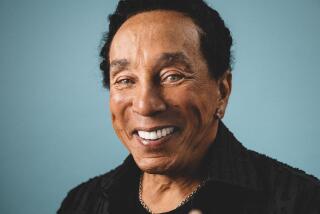The Shrewd ‘Father of Bluegrass’
- Share via
Attending a special arts and humanities luncheon hosted by President and Nancy Reagan in 1983, Bill Monroe encountered Frank Sinatra--another luncheon guest--in one of the White House waiting rooms. Sinatra immediately approached Monroe, telling him how much he admired his work, mentioning specifics, most pointedly Monroe’s early concerts at the Grand Ole Opry. Monroe’s response was typical for this enigmatic and sometimes shrewdly controlling man:
“ ‘Now what did you say your name was?’ Bill asked.
‘I’m Frank Sinatra.’
‘And what is it that you do?’
‘I’m a singer.’
‘I believe I’ve heard of you,’ said Bill, deadpan.
‘Well, I hope so,’ Sinatra replied with considerable grace.”
Richard Smith’s spirited biography brims with many such anecdotes, engaging as they are instructive about this fiercely contradictory character lauded as the “Father of Bluegrass,” who would become, according to Smith, “the most broadly talented and broadly influential figure in the history of American popular music.”
Beginning with the performer’s birth in Rosine, Ky., on Sept. 13, 1911, Smith describes how Monroe was born with an inwardly crossed eye, a disfiguring ailment that affected his vision. Until late adolescence, when he received corrective surgery, Monroe suffered teasing from his three older siblings and peers alike. This, along with his often being left to fend for himself, created in the boy intense feelings of loneliness and rivalry to which he responded with an intriguing meld of ambition and sometimes self-endangering stoicism (when the boy was 10, he suffered abdominal pain in total silence until he collapsed with his appendix about to burst).
To make matters worse, Malissa, Monroe’s mother, died when he was about 10 years old, taking with her the comfort of “her lovely music, the mountain ballads, the lilting fiddle and jaunty accordion.” On walks after his mother’s death, the boy began to practice mountain “hollering,” what Smith describes as “a special kind of keening falsetto cry that carries more efficiently than simple shouting,” and it was through this practice that he developed the lonesome and bluesy high tenor vocal style for which he would become famous.
Smith tracks Monroe’s early band playing to the at-home trio formed by himself and his older brothers Charlie and Birch, a group that would eventually perform under the name of the Monroe Brothers. Conflict among the brothers led the youngest Monroe to begin his own band, one that early on would feature the guitarist and lead vocalist Lester Flatt and banjo picker Earl Scruggs. In another of Smith’s intriguing anecdotes, he recounts how Monroe came to name the band the Blue Grass Boys. Although born and raised in a town distant from the well-known bluegrass region of Kentucky, Bill felt a keen attachment to his home state and believed that outsiders were most sure to identify him as a Kentuckian if he included “bluegrass” in his band’s name. From this and, more important, from Monroe’s penetratingly high lonesome voice and fast, innovative mandolin-playing, a distinctive genre developed, with its roots in the traditional mountain music of America’s South.
Smith discusses Monroe’s personal and professional relationships, many of which took rocky turns, but it seems that Monroe held the most enduring grudges against fellow musicians. Smith’s nuanced account of Monroe’s artistic connection to countless recording artists--including Elvis Presley, Bob Dylan, Emmylou Harris and Jerry Garcia, to name a few--maps out the particulars of his far-reaching influence on contemporary popular music.
More to Read
The biggest entertainment stories
Get our big stories about Hollywood, film, television, music, arts, culture and more right in your inbox as soon as they publish.
You may occasionally receive promotional content from the Los Angeles Times.










